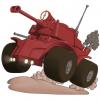I can say there is good reason to go the 3d pre-rendered to 2d sprite pipeline.
For one thing, most can agree on this, 2d games are simply more simple to make, and quicker. Much of this is tied to the art and so by doing this pipeline that advantage is negated, but other things are still gained by doing 2d. Some great game engines are geared to 2d, including for example GMStudio(by yoyogames) and Contruct 2(by Scirra). These are great engines, and tend to be quick to develop in, so you get some advantage in going 2d not only in game complexity(though 2d can have many complexities regardless) but in development time due to engine choice.
Another advantage lies in that if you simply haven't/can't learn to pixel art, and don't have the funds(or friends) to outsource your art, then 3d may be the way to go, at least pre-rendering it. I fit this case perfectly, because somehow though I've never gotten good at pixel art or even vector art, I can somehow make pretty respectable 3d models.
Another advantage lies in styling. At least for me, it is pretty easy to use the same style for all the art in pre-rendered 3d pipelines. This is because you can easily create materials that are similar, you can use the same or similar textures(if you use textures), and you can easily ensure the lighting is the same by using the same scene setup and just moving objects in and out as you need to keep everything the same.
If you get pretty good at using this art pipeline, you will find it has other general advantages. For example, once you get going, changes are much easier. You don't have to redraw all the animation yourself if you simply tweak a material or change something basic. There are exceptions to this, but for the most part things can be redone easily, including animation and material tweaks, all the way to lighting setups, for example either to change or because you want more than one in order to use different graphics in different scenes or something. Also, you can reuse some assets for different things, for example if you need a face closeup for RPG style menus or dialog boxes, or for rendering actual video scenes for the game, or lastly for other pre-rendered scenery, like if your main menu displays the character attacking an enemy or something(either video or a static image).
The last thing I will mention here....if you get good at this 3d to 2d pipeline, you have a head start for the future for example if you want to go full 3d. You've already learned much about modelling and animation and probably gotton some practice. The material settings won't be the same mostly because you need more detail than low resolution pre-renders, but much of the knowledge will still apply.









